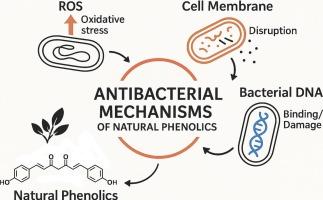天然酚类物质作为食品保鲜的多靶点抗菌剂:作用机制
IF 8.2
1区 农林科学
Q1 CHEMISTRY, APPLIED
引用次数: 0
摘要
天然酚类物质正在成为有前途的清洁标签抗菌剂,但其多靶点机制的证据仍然分散。本文综述了2013-2025年间关于大肠杆菌、金黄色葡萄球菌及其相关病原菌的158项研究。确定了三个趋同的抗菌靶点:ROS生成(72%的酚类物质),膜破坏(58%)和DNA相互作用(41%)。双去甲氧基姜黄素、没食子酸、百里香酚和表没食子儿茶素没食子酸酯(EGCG)等化合物作用于所有靶标,在≤2 × MIC下可减少细菌计数高达4 log CFU/mL。一个级联机制被提出:ROS触发脂质过氧化,削弱膜,增强酚摄取,加速DNA损伤。食物基质因子(pH值、脂肪、水分活性、微生物群)可抑制功效高达90%。新兴的递送策略-纳米乳液,生物聚合物胶囊和活性膜-部分恢复功能。这篇综述将分子见解与食品系统数据相结合,为设计健壮的酚类抗菌剂提供了一个实用的框架。本文章由计算机程序翻译,如有差异,请以英文原文为准。

Natural phenolics as multitarget antimicrobials for food preservation: mechanisms of action
Natural phenolics are emerging as promising clean-label antimicrobials, yet evidence for their multitarget mechanisms remains scattered. This review synthesizes 158 studies (2013–2025) on Escherichia coli, Staphylococcus aureus, and related pathogens. Three converging antibacterial targets are identified: ROS generation (72 % of phenolics), membrane disruption (58 %), and DNA interaction (41 %). Compounds such as bisdemethoxycurcumin, gallic acid, thymol, and Epigallocatechin gallate (EGCG) act across all targets, reducing bacterial counts by up to 4 log CFU/mL at ≤2 × MIC. A cascade mechanism is proposed: ROS triggers lipid peroxidation, weakening membranes, enhancing phenolic uptake, and accelerating DNA damage. Food matrix factors (pH, fat, water activity, microbiota) can suppress efficacy by up to 90 %. Emerging delivery strategies—nanoemulsions, biopolymer capsules, and active films—partially restore function. This review integrates molecular insights with food system data, offering a practical framework for designing robust phenolic-based antimicrobials.
求助全文
通过发布文献求助,成功后即可免费获取论文全文。
去求助
来源期刊

Food Chemistry: X
CHEMISTRY, APPLIED-
CiteScore
4.90
自引率
6.60%
发文量
315
审稿时长
55 days
期刊介绍:
Food Chemistry: X, one of three Open Access companion journals to Food Chemistry, follows the same aims, scope, and peer-review process. It focuses on papers advancing food and biochemistry or analytical methods, prioritizing research novelty. Manuscript evaluation considers novelty, scientific rigor, field advancement, and reader interest. Excluded are studies on food molecular sciences or disease cure/prevention. Topics include food component chemistry, bioactives, processing effects, additives, contaminants, and analytical methods. The journal welcome Analytical Papers addressing food microbiology, sensory aspects, and more, emphasizing new methods with robust validation and applicability to diverse foods or regions.
 求助内容:
求助内容: 应助结果提醒方式:
应助结果提醒方式:


